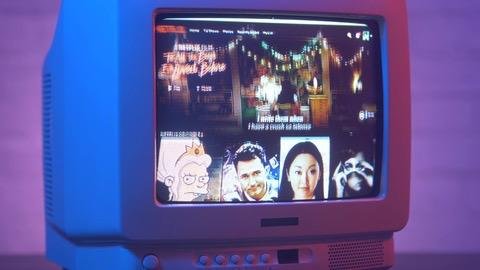Why is "Bad TV" So Good?
(Photo/Netflix On A Vintage Old Crt Tv Screen 80S 90S Style Video/Vulk)
By Irmak Ersoz
Admit it, you’ve been there: After a long day of lectures convincing you multilateralism is dead followed by subway doom-scrolling of the hottest NYC cafés alongside global armed conflict, you just want to not think for a little bit. When you finally get home, the couch calls your name. Who wants to work on seemingly endless problem sets when you can stare at yet another high school love triangle unfolding on the screen?
Don’t worry. Netflix has your back. Would you prefer a country version of The Summer I Turned Pretty, or every reality TV show Netflix has ever produced mashed up into a chaotically enjoyable dating show? There’s something for everyone—from the true crime girlies to the Love Island superfans. But where is all of this TV coming from?
With their viewership concentrated in cynical millennials and fed-up Gen-Z’ers, new-generation streaming giants like Netflix, Hulu, and Prime Video have perfected the art of modern TV. As viewership nearly quadrupled over the pandemic, these platforms pumped unparalleled amounts of money into in-house productions: in 2024 alone, the six largest streaming companies spent $40B of their collective budgets on in-house content, or more than 30% of their spending. And in streaming, money talks: in-house content is cheaper, quicker to turn around, easier to market, and more resilient to failure. While deemed risky pre-pandemic, Netflix makes more of its income from dozens of its “efficient” originals today, rather than a single licensed blockbuster.
But, does quantity diminish quality? Arguably, some of the TV I’m referencing isn’t even “bad.” Amid the flurry of high school romances and CIA escapades, Netflix has made some true masterpieces. Shows with complex protagonists and charged plotlines like The Bear and Severance break viewership records alongside Love Island and The Golden Bachelor.
On the surface, many in-house productions appear promising, with star-studded casts and beloved screenwriters. But, turned around at lightning speed, new TV pilots take much less risk than the original in-house efforts like Orange is the New Black or House of Cards. They follow predictable storylines deemed profitable by the streaming data, promising just enough for you to click “Next Episode” and spend your Sunday on the couch.
While platforms worked to “scale” production to make themselves more resilient to financial losses, they didn’t expect the viewership to scale in tandem. However, our generations proved them wrong: increasing loneliness combined with rampant political burnout paved the way for our generation’s persistent cravings for new content at the drop of a hat. 53% of Gen Z has traded political news for some form of escapism, including binge-watching.
Times columnist James Poineowik argues that the sheer scale of TV production by streaming services, accompanied by an audience of young adults exhausted from watching the world crash and burn, has ushered in the reign of mid TV. While streaming platforms have monstrous budgets at their disposal to make gems like Succession ten times over, making another neighborhood crime show with a clueless girl-next-door and a semi-attractive detective promises more stable returns faster. There is comfort in predictability, both for the viewer and the producer. We watch what we’re familiar with: scripts that vaguely resemble another show, questions like “How did Idris Elba find himself stranded on a plane… again?”, and the good old couch bickering with friends on why the Golden Bachelor is SO much better than the original.
Mid isn’t just easy; it’s entertaining, too. There is a unique fun in questioning which writer decided Noah Centineo could survive infiltrating a Russian air base, wearing all-white with no gun. Despite binge-watching The Recruit in its entirety while writing a policy memo, I still don’t know how he walked out of that alive. That discourse extends beyond my living room: Our chronically online generation loves taking apart “The Netflix Curse” or simply an uncharacteristically mid finale on every social media platform at our disposal.
Perhaps, in a world of constant shock,“good enough” is a subconscious comfort. When you know what’s going to happen by episode 4, you can “turn off your brain,” as my friends like to call it. Whether it’s overly optimistic survival chances for Noah Centineo or another perfect shot of Conrad looking at Belly, predictable simplicity maybe just gives our brains some room to breathe, something light to talk about, or something to fill the silence as we go about our days.
So, do we even want good TV anymore? Has the purpose of TV shifted from steering American culture to serving as background noise while you get your daily TikTok digest? Or are we just too used to content that we have to drown out that we’ve begun to crave it? I might not be a marketing analyst or a psychologist, but with the legitimacy bestowed upon me by countless hours of good and bad TV, I can confidently say that I don’t know…but I will surely be tuning in for the fourth season of The Recruit when finals roll around.

